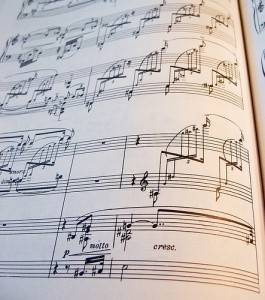 A few months ago, I read an research article about sight-reading that stated that professional pianists read something like eight notes ahead at any given time while sight-reading (I wish I could cite the article, but I don’t remember where I found it – if anyone knows of it please tell me!). The article, however, wasn’t very clear about what the “eight notes” referred to (harmonically? melodically?), especially since it seems that this would change depending on the texture, meter, and tempo. Regardless, I found it interesting to consider how far ahead one can be looking and thinking ahead while reading in order to be better prepared for what is coming up. (How many notes can YOU think ahead?)
A few months ago, I read an research article about sight-reading that stated that professional pianists read something like eight notes ahead at any given time while sight-reading (I wish I could cite the article, but I don’t remember where I found it – if anyone knows of it please tell me!). The article, however, wasn’t very clear about what the “eight notes” referred to (harmonically? melodically?), especially since it seems that this would change depending on the texture, meter, and tempo. Regardless, I found it interesting to consider how far ahead one can be looking and thinking ahead while reading in order to be better prepared for what is coming up. (How many notes can YOU think ahead?)
Personally, I think reading is mostly about “chunking” – recognizing groups of notes as chords, patterns, and other groupings. I do find, however, that students benefit greatly from being taught to “look ahead” or “think ahead.”
A young student of mine this week was playing a two-lined piece where the RH and LH move up an octave to echo what was stated in the previous two measures. The first time she played the piece, she had to briefly pause to think and move her hands to the right place before going on. She had been practicing this piece all week and I could tell she knew where her hands needed to go. Nevertheless, the spot was catching her unaware. Mentally, she wasn’t prepared for the octave move and therefore her hands weren’t ready on time either. We talked about this, and we reasoned together that she needed to be thinking ahead in order to be ready on time. After this, of course, she was able to play the piece fluidly.
Now the question may be, is it more effective to instruct students to “look ahead” or “think ahead?” Any opinions?



I teach my students what I learned from my college professor – that to really learn a piece of music, you have to “hear” it, “feel” it and “see” it (and I add that you can’t “smell” it or “taste” it – although I may be wrong in that assessment.) Because of this protocol, I am fairly certain that I tell them to “look” ahead. But maybe that’s wrong? Because we don’t really want them to “look,” do we, because they might start looking at the wrong thing? We want them to “think,” don’t we, because the music must eventually become external? Well, this is indeed a very good question. Maybe they should learn that they must “see” what’s ahead? (And again, according to John Assaraf, you don’t “see” with your eyes, you “see” with your brain.) Joy, your posts always stimulate my thinking! Thanks so much!
I tend to think that both “looking” and “thinking” are needed. I teach my students that when they have a rest in one (or both) hands, they should be looking ahead to where their hands need to be next, especially if there is a fingering or hand placement change. Even when there aren’t rests involved it is a good practice to know what is ahead. I don’t really think it’s possible to look ahead and not think (maybe I’m wrong!) but when I play I am always doing both.
I guess it kind of depends on what you’re doing… if you’re reading a piece for the first time you can’t really ‘think ahead’ since you’re not totally sure what’s coming (unless you’ve had the luxury of getting some time to look it over before playing)… so in this case you would def. need to ‘look ahead’. But both ‘looking’ and ‘thinking’ ahead gives you the best of both worlds. I can say that my own sight reading greatly improved a few years ago when I purposed and practiced looking a measure ahead in the score.
Great post, Joy!